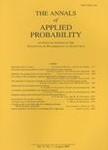-
作者:De Angelis, T.; Peskir, G.
作者单位:University of Leeds; University of Manchester
摘要:We show that if either the process is strong Feller and the boundary point is probabilistically regular for the stopping set, or the process is strong Markov and the boundary point is probabilistically regular for the interior of the stopping set, then the boundary point is Green regular for the stopping set. Combining this implication with the existence of a continuously differentiable flow of the process we show that the value function is continuously differentiable at the optimal stopping b...
-
作者:Ettinger, Boris; Hening, Alexandru; Wong, Tak Kwong
作者单位:Tufts University; University of Hong Kong
摘要:The classical inverse first passage time problem asks whether, for a Brownian motion (B-t)(t >= 0) and a positive random variable xi, there exists a barrier b : R+ -> R such that P{B-s > b(s), 0 <= s <= t} = P{xi> t}, for all t >= 0. We study a variant of the inverse first passage time problem for killed Brownian motion. We show that if lambda > 0 is a killing rate parameter and 1((-infinity,)(0]) is the indicator of the set (-infinity, 0] then, under certain compatibility assumptions, there e...
-
作者:Bezborodov, Viktor; Di Persio, Luca; Krueger, Tyll; Tkachov, Pasha
作者单位:Wroclaw University of Science & Technology; University of Verona; Gran Sasso Science Institute (GSSI)
摘要:We consider the speed of propagation of a continuous-time continuous-space branching random walk with the additional restriction that the birth rate at any spatial point cannot exceed 1. The dispersion kernel is taken to have density that decays polynomially as vertical bar x vertical bar(-2 alpha) , x -> infinity. We show that if alpha > 2, then the system spreads at a linear speed, while for alpha is an element of (1/2, 2] the spread is faster than linear. We also consider the mesoscopic equ...
-
作者:Harris, Simon C.; Johnston, Samuel G. G.; Roberts, Matthew I.
作者单位:University of Auckland; University College Dublin; University of Bath
摘要:Take a continuous-time Galton-Watson tree. If the system survives until a large time T, then choose k particles uniformly from those alive. What does the ancestral tree drawn out by these k particles look like? Some special cases are known but we give a more complete answer. We concentrate on near-critical cases where the mean number of offspring is 1 + mu/T for some mu is an element of R, and show that a scaling limit exists as T -> infinity. Viewed backwards in time, the resulting coalescent...

